Art History
Satire or Celebration? Three Insightful Facts About Goya’s Royal Portrait
Is Queen María Luisa the true star of Goya's famed royal portrait?
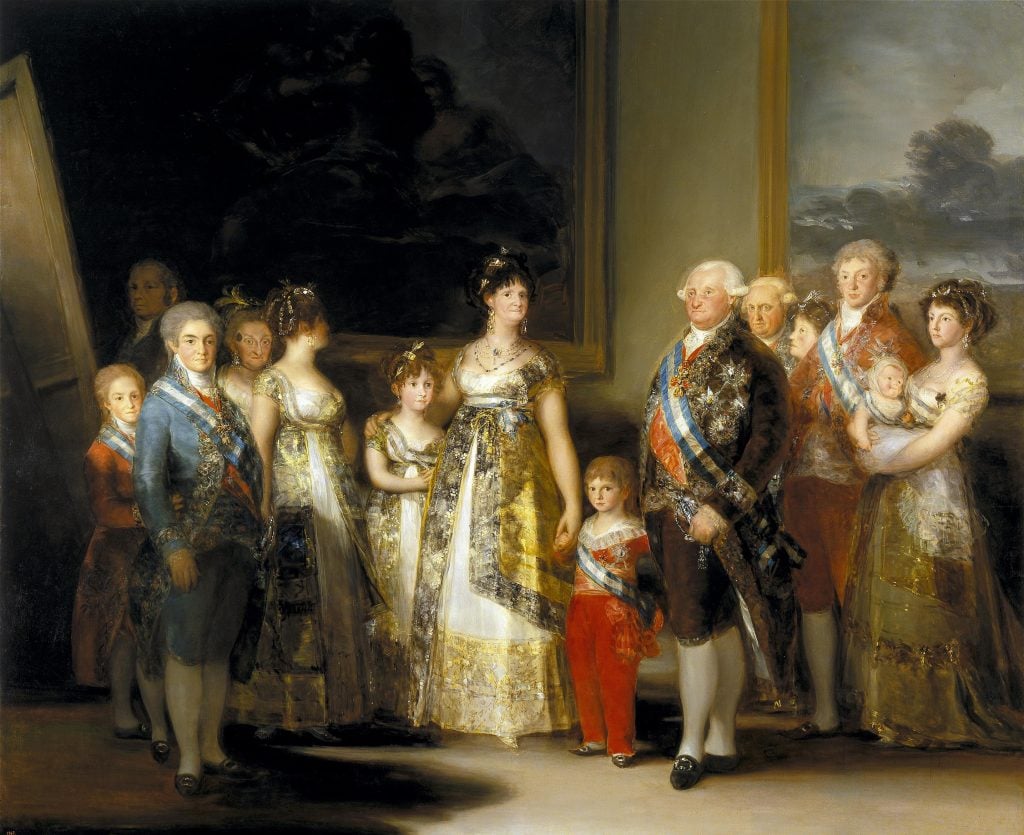
The most devastating insults land with precision. Such was the case for a 19th-century critic who skewered Francisco Goya’s Carlos IV of Spain and His Family (1800–1801), in a single line: “It looks as if the corner baker and his wife have won the lottery.”
The exact source of this quote was hard to pinpoint, in part because so many people enjoyed repeating versions of it. Among them was the Impressionist painter Pierre-Auguste Renoir, novelist Alphonse Daudet, and poet Théophile Gautier, though its earliest usage has been ascribed to the Belgian art critic Lucien Solvay.
More clear is the way that this oft-repeated critique has helped to popularly define the painting as a satirical caricature of the royal family, and positioned Goya, in turn, as an artist undermining his employer. This is especially the case in art history survey books. H.W. Janson saw among a “collection of ghosts” a “bloated vulture of a king” and a “grotesquely vulgar queen.” Similarly, Helen Gardner found “a menagerie of human grotesques,” branding them a hoard of captive animals, primped and paraded out for display.
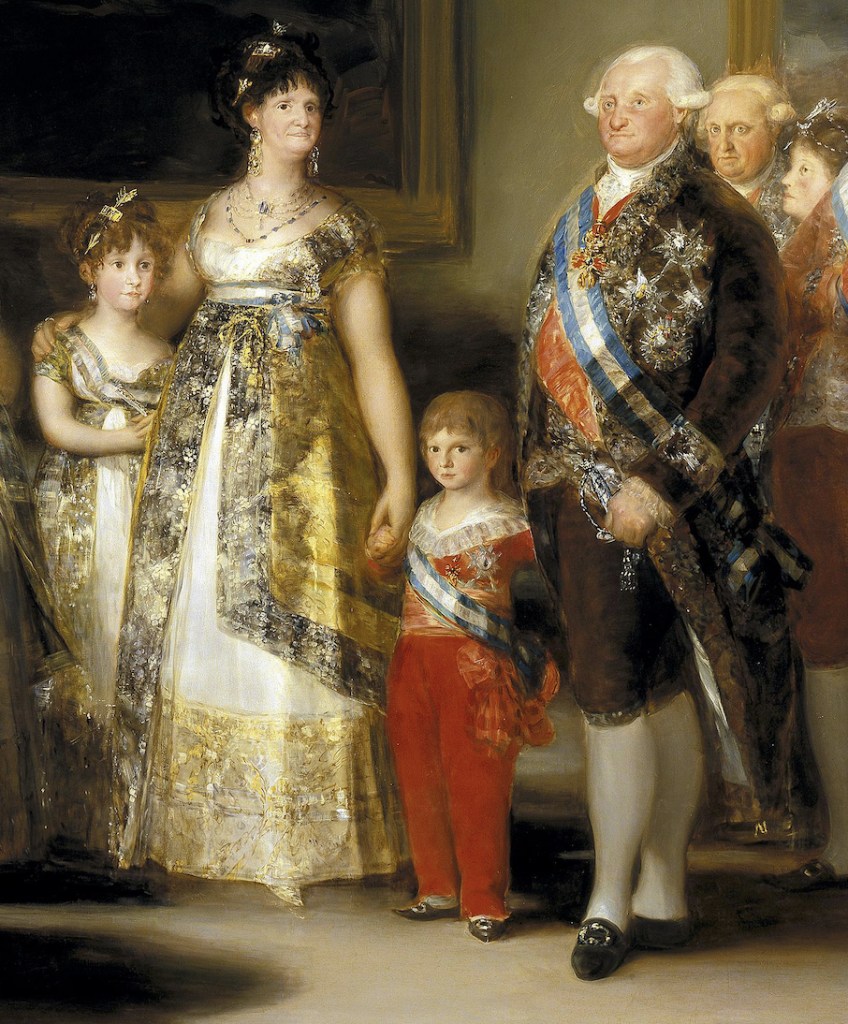
Details of Francisco Goya’s Retrato de María Luisa de Parma en traje de corte (1799).
The persistence of the narrative aligns with other works by Goya, such as Los Caprichos, a 1799 collection of etchings that laid bare the “human error and vice” of contemporary society. Yet, Goya biographer Janis Tomlinson has explained that these satires weren’t viewed as quite so objectionable by the monarchy. In 1803, Carlos IV even acquired the copper plates for the series so prints could be made and sold to the public.
For much of his life, Goya was a most loyal servant of the monarchy, becoming the first Spanish artist since Diego Velázquez to hold the prestigious position of first court painter. It was a career and salary he long aspired to, and he worked diligently within the system to keep it.
Much of this goodwill was achieved through portraiture, which accounted for one third of his lifelong output. In these works, Goya adopted a penetrating natural style that built upon a frank but never demonizing observation of his sitters. Lauded as the greatest portrait painter of his time, he completed commissions for politicians, Enlightenment intellectuals, and aristocracy.
This talent is on full display in Carlos IV of Spain and His Family, a frieze-like arrangement of the Bourbon family and Goya, working in the shadows. The royals form groupings, somewhat respectful of rank, across three generations, exuding the kind of inscrutable self-confidence one is only born into. The center is held by Queen María Luisa, King Carlos IV, and their young children, the Infanta María Isabel and Infante Francisco de Paula. Behind the King waits his brother Infante Antonio Pascual and his brother’s recently deceased wife, Infanta María Amalia. The monarchs’ daughter Infanta María Luisa, her strapping husband, Don Luis de Bourbon, the later king of Etruria, and their infant son round out this side.
On the left, the King and Queen’s eldest son and heir to the throne, Ferdinand, Prince of Asturias, mirrors the stance of his father. A dagger-like shadow emanates from his feet in the direction of the King, a reflection perhaps of the courtly gossip always swirling around rulers, ever fearful of a usurping son. His brother Infante Don Carlos, second in line, holds his waist from behind as if indicating this succession. Ferdinand’s future wife, her identity then unknown, turns away from us, obscuring her blank face. Finally, the King’s sister Infanta María Josefa wears a sour expression. The large mole on her temple might be a chiqueador, a fake beauty mark once considered the height of European fashion but by this time a relic of the now-dated trend.
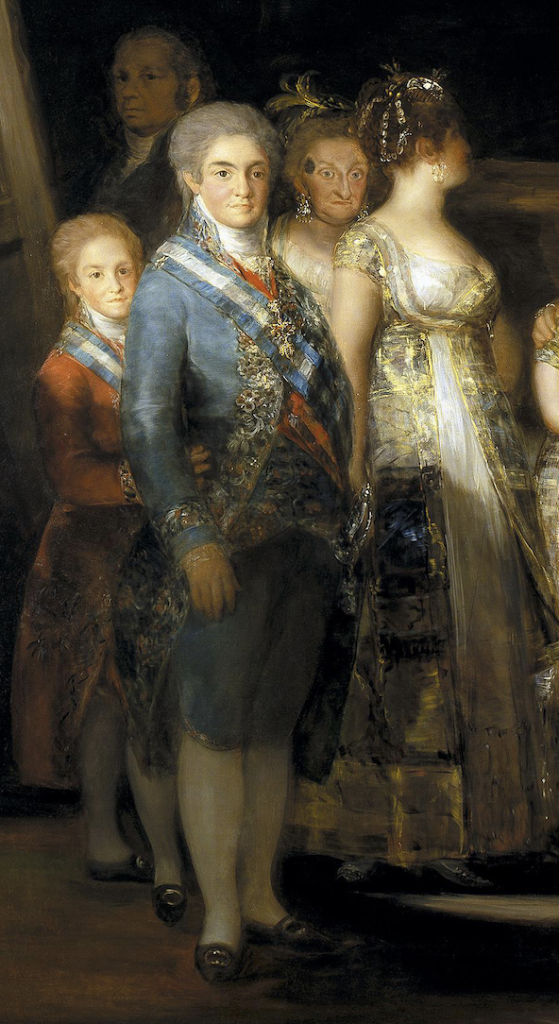
Details of Francisco Goya’s Retrato de María Luisa de Parma en traje de corte (1799).
A splendid freeness defines Goya’s handling of paint, especially around the badges and sashes which adorn Carlos IV and his son, and in the intricate patterning of the ladies’ fashionable Greek-style dresses. Light streams in, catching the metals, jewels, and sumptuous fabrics, and illuminates the figures with a warm, metallic glow, like glass Christmas ornaments studded with glitter.
Created following Goya’s series of full-length and equestrian portraits of the King and Queen, the family picture was most likely intended to decorate the Royal Palace in Madrid, perhaps hanging in a series of rooms used to receive distinguished visitors. Today it hangs in the Museo del Prado alongside other works from the former Spanish Royal Collection. A masterpiece on a grand scale, it proclaims the strength of the Bourbon dynasty during a period we now know was rather tenuous: the French Revolution was just over a decade behind them, and in eight years Napoleon would install his brother, Joseph Bonaparte, on the Spanish throne.
Goya Took Inspiration From Las Meninas—And Nature
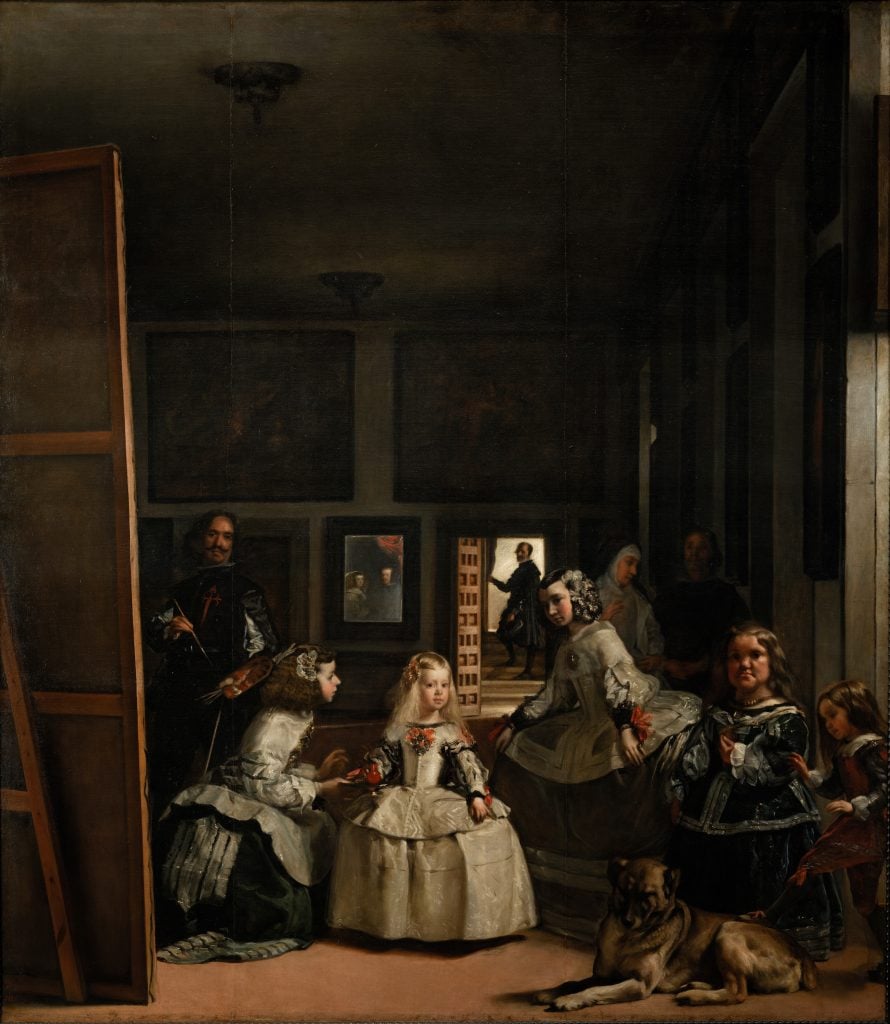
Diego Velázquez, Las Meninas (1656). Collection of Museo del Prado, Madrid.
Goya aspired to a career like Velázquez, the highly acclaimed court painter who developed a close relationship with Philip IV of Spain. Goya’s son, Javier, explained, “He looked with veneration at Velázquez and Rembrandt, but above all he looked at Nature, whom he called his mistress.”
Comparison between Carlos IV of Spain and His Family and Velázquez’s Las Meninas (then known as The Family of Philip IV) is often made. Goya had not only seen this work and others by Velázquez in the Royal Collection, but he made drawings and etchings after them, about 20 in total. Goya studied and interpreted the style of the Sevillian master, sometimes adding his own ideas, which suggests Goya’s intent to learn from Velazquez’s highly praised “natural style.”
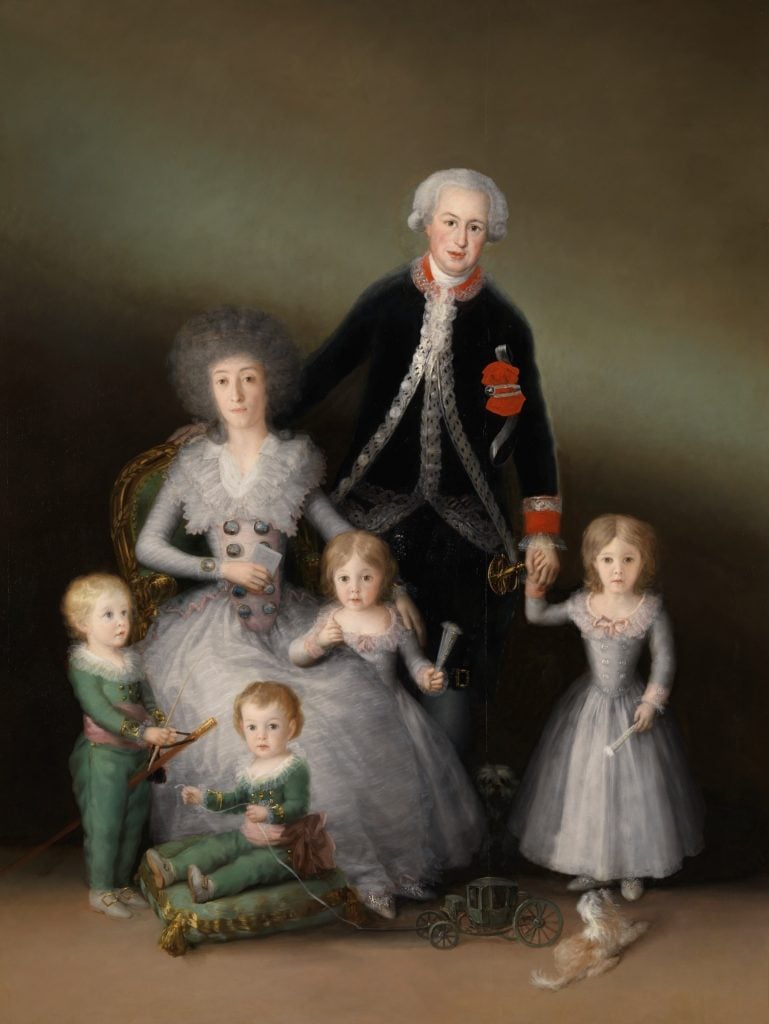
Francisco Goya, The Duke and Duchess of Osuna and their Children (1787–1788). Collection of Museo del Prado.
Compositionally, this influence is evident in Carlos IV of Spain and His Family. The frontal arrangement of figures in discrete groups, the presence of the artist and easel, and the inclusion of background paintings all allude to Las Meninas. But there are some notable differences. The deep, more perspectival space in the Velázquez is substituted for a shallower, and therefore more immediate, even claustrophobic, engagement with the family. Where some of the Infanta’s retinue turn away in Las Meninas, absorbed in their own happenings, in Goya’s work most of the figures face or engage the viewer, save some wandering eyes. This awareness contributes a sense of artificiality to their lineup, like the deliberate placements of a manger scene. The cut-and-paste feeling of a group portrait paradoxically composed of individual portraits might be heightened by Goya’s preparatory process. The artist created ten individual sketches of the family members from life, paying careful attention to capture the likenesses of their faces, which he relied on for the final work.
This was also not the first time Goya had turned to Las Meninas—he used it to help define earlier group compositions for The Family of Infante Don Luis (1783), and The Duke and Duchess of Osuna and Their Children (1789). It helped inspire Goya to upend conventions of the family portrait tradition: gone is the soaring classical architecture that dwarfs the mostly seated royals in The Family of Philip V (1743), by Louis-Michel van Loo.
Famously, Las Meninas is a painting about painting. Carlos IV of Spain and His Family likewise announces Goya’s artistic skill. Tomlinson explained, “Because, like Las Meninas, La Familia is an unusual royal portrait, with nuanced physiognomies and sumptuous depictions of costumes that would gleam in the candlelight that originally illuminated them. This mastery directs attention to the power of the painter no less than to the persons portrayed. We are facing a portrait designed to please not the masses but the artist’s most illustrious client.”
The Paintings in the Background Add Layers of Meaning
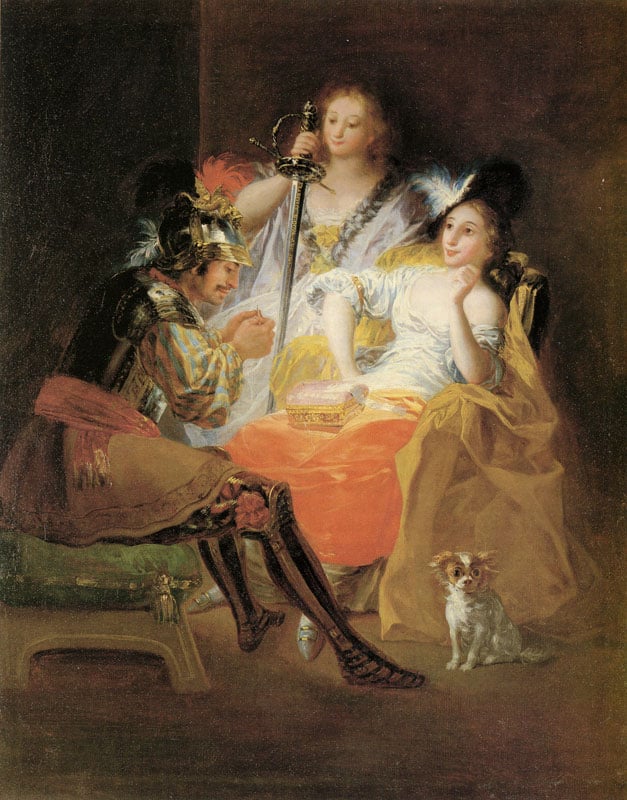
Francisco Goya, Hercules and Omphale (1784).
Paintings in the backgrounds of paintings have long been a way for artists to leave morsels of meaning within their works. In Las Meninas, Velázquez includes two allegorical scenes from Ovid’s Metamorphoses painted by Peter Paul Rubens. These mythic examples of artistic achievements served to elevate Velázquez’s profession, while also aligning him with the acclaimed Flemish master.
Likewise, the background paintings in Carlos IV of Spain and His Family have drawn significant attention, mostly after the work was cleaned, in 1967, to remove the darkened layers of varnish. Unlike the small paintings in the deep room of Las Meninas, the background paintings in Goya’s shallow stage take up nearly half the wall, and our proximity to the tableaux heightens their presence.
In the work on the left, three figures in moody, insubstantial shadows appear to be seated on a rock. A naked man with dark, curly hair faces us, while a female figure, exposed from the waist up, turns away. In the right corner, a second woman in a veil holds an open book on her lap and exposes one breast.
This figural painting has evoked numerous interpretations by scholars, and given its prominent placement behind Maria Luisa, is reflective of her character. It has been identified as a Bacchic scene featuring Goya himself; as the Biblical tale of Lot and his daughters (a disturbing story fuelled by a desire to preserve the family lineage); as the Three Graces, which casts the black-haired figure as a woman; as the three Fates; and as a classical scene of the afterlife.
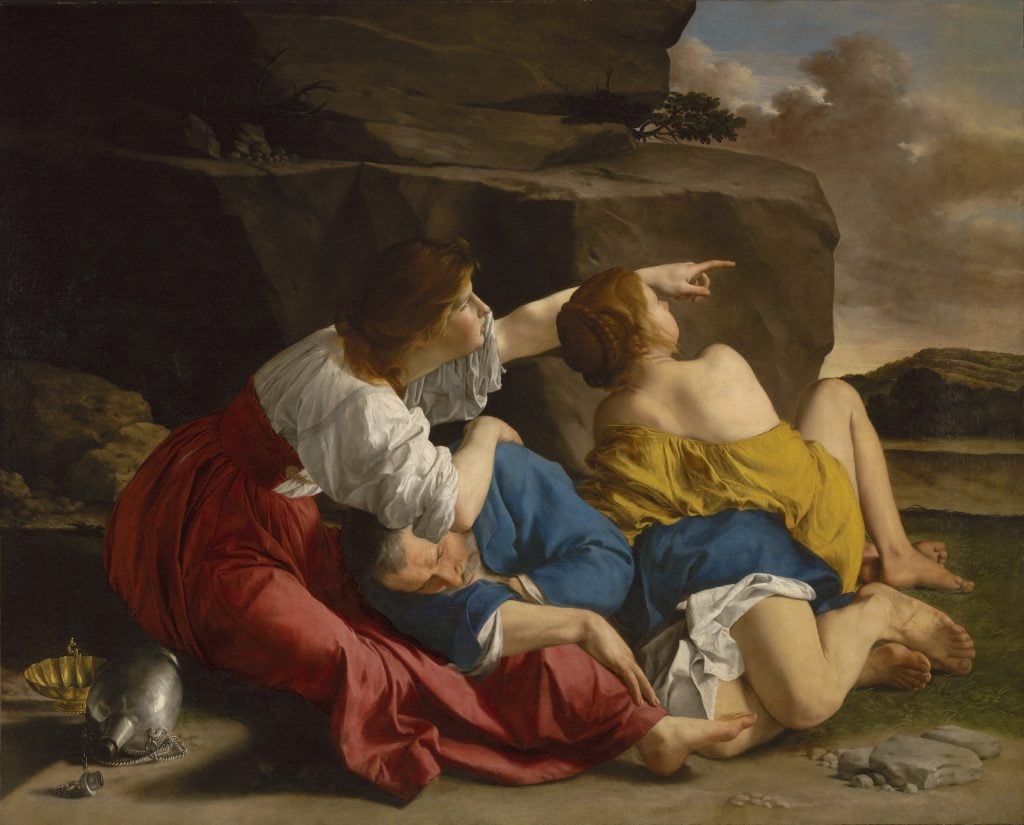
Orazio Gentileschi, Lot and His Daughters (1622). Collection of the J. Paul Getty Museum, Los Angeles.
Yet the art historian and Prado curator Manuela Mena Marqués sees these readings as too bound up in historical judgments of the family. Instead, she interprets an allegorical scene of either Hercules and Omphale or Hercules and Iole, the former of which Goya had painted in 1784. As Marqués explained, Hercules holds associations with the Spanish monarchy, who claimed the hero as the originator of their divine lineage. Since the 16th century, images depicting Hercules’s triumphs had decorated the royal residences and palaces. “The painting is an allegorical representation, perfectly calculated, of the importance of dynastic continuity, as well as the full right to the throne of Spain for the House of Bourbon,” Marqués noted, “and it is also an evident praise for the high number of its members, as many sons and daughters as the monarchs had managed to give to Spain.”
On the right, in freer strokes, the landscape features windswept trees and an ocean horizon, possibly fed by a river along the foreground. Marqués again finds in the invented work (unlike Velázquez, both paintings emerge from Goya’s imagination) a positive symbol of Spain, alluding to its maritime power. If Hercules represents the mythic past, the landscape proclaims a flourishing present and hopeful future. The King stands in the space between both compositions as the link between eras.
Queen Maria Luisa Takes Center Stage
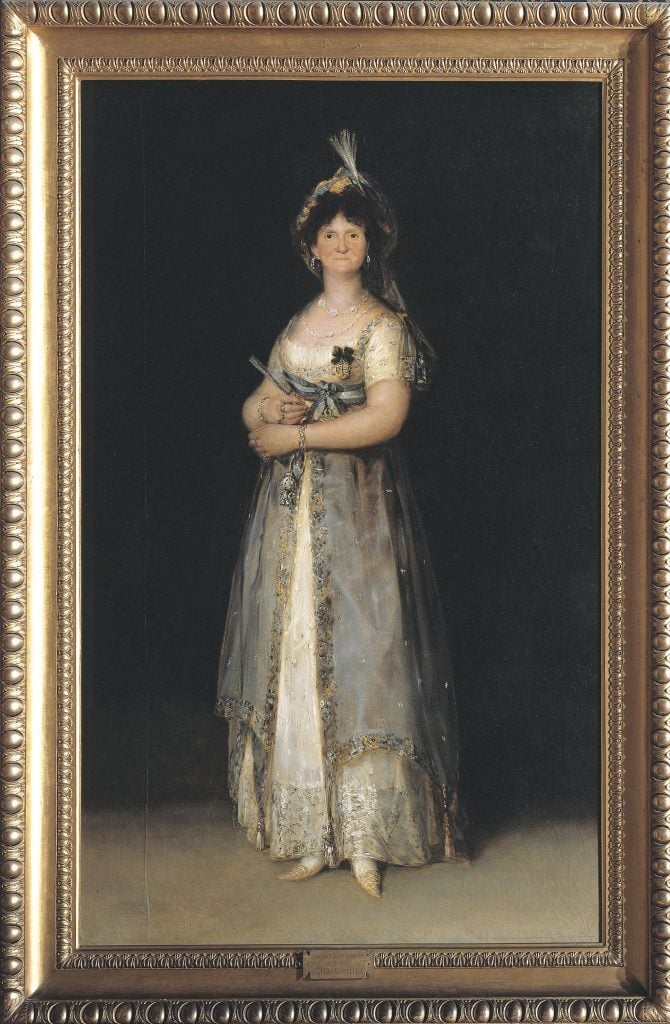
Francisco Goya, Retrato de María Luisa de Parma en traje de corte (1799).
Though the King is in this prominent, forward position, it is Queen Maria Luisa who occupies a different center, a motherly force of stability and majesty. Whereas many of the other figures are partially in shadow, the Queen is fully illuminated, radiating before us, her piercing gaze revealing the strength of her character.
The portrait’s overall familial closeness aligns with emerging Enlightenment ideals that transformed thinking around childhood and upbringing, with a focus on affection and engagement. As if echoing this sentiment, Maria Luisa cradles her daughter’s shoulders and lovingly extends her arm to her son. Now in her 50s, the Queen had given birth to fourteen children, though only seven survived to adulthood, and she suffered ten miscarriages. Twenty-four pregnancies took a toll on her body, aging her prematurely, depleting her calcium, and contributing to the loss of her teeth.
The Russian ambassador, Stepan Zinoviev, explained: “Repeated childbirths, indispositions, and perhaps a germ of hereditary disease have completely withered her: the yellow tint of her complexion and the loss of her teeth were the mortal blow to her beauty.” Comments like this about the Queen were not uncommon. She was the favored subject of maligning gossip, during her own time and after, and these often defamatory accounts—written in diplomatic correspondence and printed in French political pamphlets—frequently focused on her intimate life with reports of scandalous love affairs. So common and accepted was this mistreatment, Marqués cautioned, that many biographers and historians have relied on unfounded testimony.
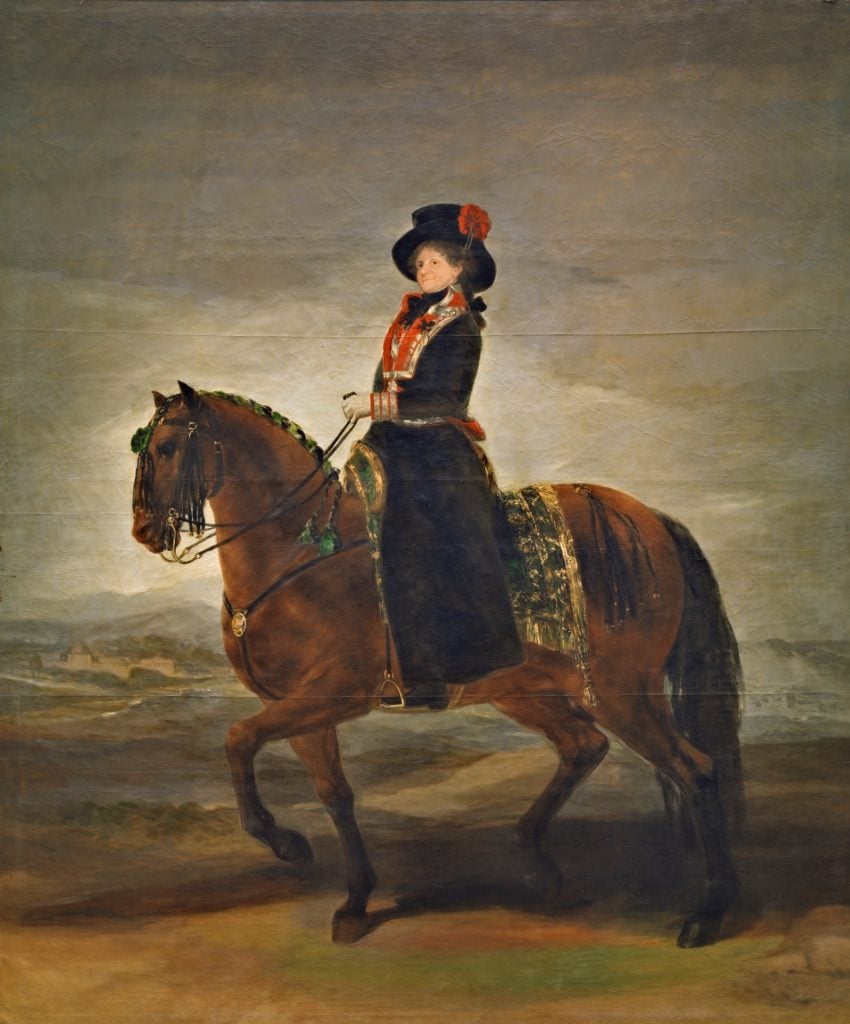
Francisco de Goya, Queen María Luisa on Horseback (1799). Collection of Museo del Prado.
Despite this, the Queen embraced her strengths—her strong figure and beautiful arms, which we see proudly on display in this and other works by Goya. So well known was this preference that the Duchess of Abrantes noted that the Queen would have readily eliminated the entire ceremonial tradition of wearing gloves to best reveal her assets. After seeing a portrait of Maria Luisa, the poet Manuel Machado wrote: “Upon contemplating the forced youth / of this flexible and still light body / the forced inclination of the hat / and the inextinguishable fire in the gaze / the posture is still gallant, still has / a graceful bearing the royal person / of this arrogant old woman, this amazon.”





